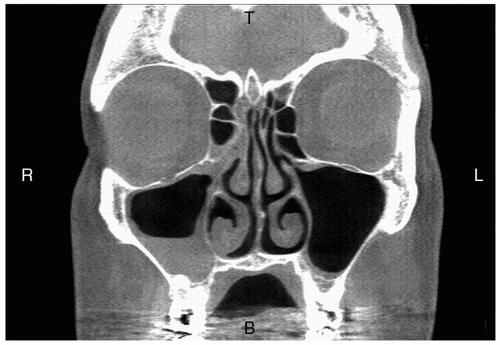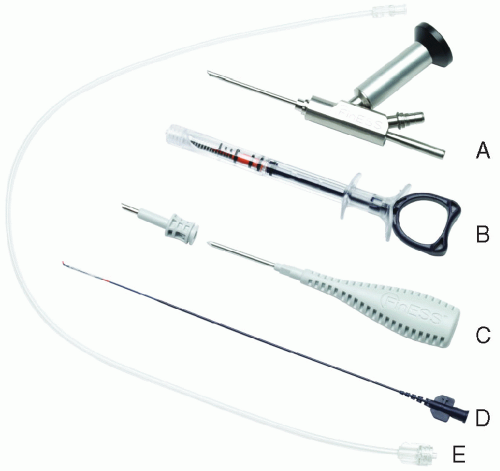Transantral Balloon Dilation
James Stankiewicz
INTRODUCTION
The endoscopic surgical treatment of maxillary sinusitis has multiple options. These options range from balloon sinuplasty to partial maxillectomy. Balloon sinuplasty with access to, and dilation of, the maxillary ostium and ethmoid infundibular space can be performed using either a transnasal or a transantral approach. This chapter will describe transantral dilation of the maxillary sinus ostium and ethmoid infundibulum. Since the surgery is transantral, it can be performed either in the clinic or in outpatient surgery under local or general anesthesia.
HISTORY
The typical patient best suited for transantral balloon dilation has refractory maxillary sinusitis with or without limited anterior ethmoid disease. The patient would have failed medical therapy with antibiotics and topical steroids and may report ongoing severe facial congestion, nasal drip, anosmia, headaches, dental pain, halitosis, or fatigue. There is no history of polyps, primary ciliary dyskinesia, or Samter triad. The patient could also have a history of recurrent acute maxillary sinusitis.
PHYSICAL EXAMINATION
Physical examination includes sinus endoscopy showing nasal congestion and edema. In some cases, the middle turbinates may be somewhat lateralized resulting in lateral displacement of the uncinate processes and thereby narrowing of the infundibular region. The septum is relatively straight, although an asymptomatic septal deviation would not contraindicate transantral balloon dilation.
The CT scan in the typical patient reveals mucosal edema blocking the osteomeatal complex extending into the maxillary sinus and anterior ethmoid sinuses.
INDICATIONS
Indications for surgery include recurrent acute and chronic maxillary sinusitis refractory to medical therapy. Sinus disease should be limited to the maxillary sinuses and anterior ethmoidal sinuses, so the surgical choices include endoscopic anterior ethmoidectomy with maxillary antrostomy in the outpatient OR, transantral balloon sinuplasty in the OR using local anesthesia with or without intravenous sedation, or transnasal balloon dilation in the clinic using local anesthesia or in the OR using local, sedation, or general anesthesia. In this illustrative case, transantral, bilateral balloon dilation of the maxillary ostia and ethmoid infundibula is selected (Fig. 12.1). Patients with turbinate hypertrophy or an asymptomatic septal deviation combined with middle
meatal narrowing are also good candidates for clinic or outpatient transantral maxillary ostial dilation. Since it can be performed in the clinic, the cost of the balloon procedure is substantially lower when compared to surgery in the operating room. The risks and complications are reduced as well since general anesthesia is replaced with a local anesthesia protocol to manage patient comfort.
meatal narrowing are also good candidates for clinic or outpatient transantral maxillary ostial dilation. Since it can be performed in the clinic, the cost of the balloon procedure is substantially lower when compared to surgery in the operating room. The risks and complications are reduced as well since general anesthesia is replaced with a local anesthesia protocol to manage patient comfort.
CONTRAINDICATIONS
Patients with thickened polypoid mucosa excessive enough to inhibit the visualization of the maxillary ostium should not be considered candidates for a transantral approach. Large retention cysts can be drained, and biopsies can be taken with the transantral equipment. The inability to gain entrance into the maxillary sinus due to markedly osteitic bone or perhaps hypoplastic maxillary sinus is a contraindication.
PREOPERATIVE PLANNING
The CT scan obtained after optimal medical treatment typically reveals bilateral narrowed ostiomeatal complexes with mild anterior ethmoid and maxillary sinus thickening (Fig. 12.1).
Whether surgery is done in the operating room or clinic, proper materials for anesthesia are necessary. The preoperative CT scan should be reviewed prior to the procedure to assess for any of the following: bowed nasal wall; hypoplastic antrum; infraorbital (Haller cells); accessory ostia; occluded maxillary ostia; ostium position; and amount of mucosal thickening/fluid. This review will help to identify not only the optimal location for antral access but also the presence of any challenging anatomy that may limit success of the transantral approach. Additionally, the CT scan should be available in the procedure room as it provides a road map for successful advancement of the balloon catheter to its desired predilation location. The transantral balloon kit (Fig. 12.2) including the microtrocar, access sheath, balloon catheter, inflation device, endoscope, and extension tube (optional) should be prepped and ready for use. Appropriate marking of surgical sides is performed.
SURGICAL TECHNIQUE
The patient is brought into the clinic procedure room, seated in the examination chair, and reclined approximately 45 degrees for patient comfort and optimal positioning for access and equipment orientation during the procedure. Nasal topical decongestant (e.g., Afrin or Neo-synephrine) and 4% lidocaine (e.g., Xylocaine) anesthetic spray are administered. Nasal pledgets are soaked in topical decongestant either 4% lidocaine or 2% tetracaine (e.g., Pontocaine) and placed in the middle meatus between the inferior turbinate and the nasal septum. Benzocaine gel (Hurricaine gel) or 4% lidocaine-soaked pledgets are also placed beneath the lips at the location of planned access into the maxillary antrum through the canine fossa. After approximately 10 minutes of local anesthesia, all pledgets are removed and 2 to 3 mL per side of 1% lidocaine with epinephrine 1:100,000 is injected into the uncinate process, the root of the middle turbinate, the anterior middle turbinate, and at the canine fossa access site. A thorough blanching of the tissue should be observed. The pledgets are replaced, and a second 10-minute wait is recommended before starting the procedure.
To access the maxillary sinus and avoid injury to any branches of the superior alveolar nerves, the lip is retracted near the canine fossa recess and the gingival tissue is palpated to locate the intersection of the midline of the pupil and the vestibule of the nose (Fig. 12.3). The microtrocar and access sheath are advanced through the soft tissue and placed onto the surface of the bone. After reconfirming the microtrocar tip position at this intersection, light forward pressure is applied with simultaneous back-and-forth rotation (±120 degree) until complete penetration through the bone is achieved. Rotation continues while the handle of the microtrocar is angled gently downward and toward the medial canthus (Fig. 12.4)




Stay updated, free articles. Join our Telegram channel

Full access? Get Clinical Tree




